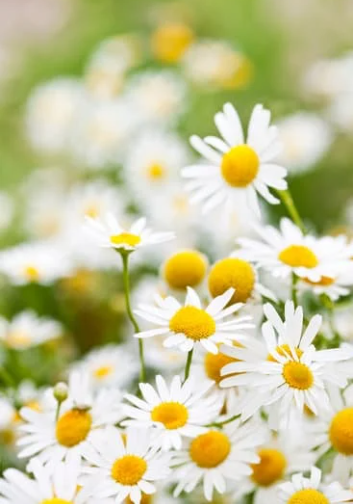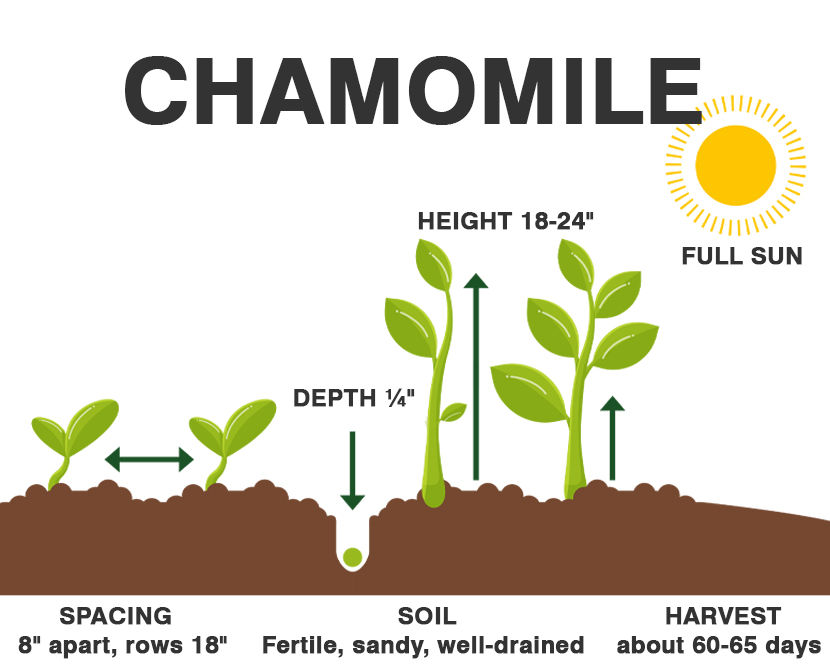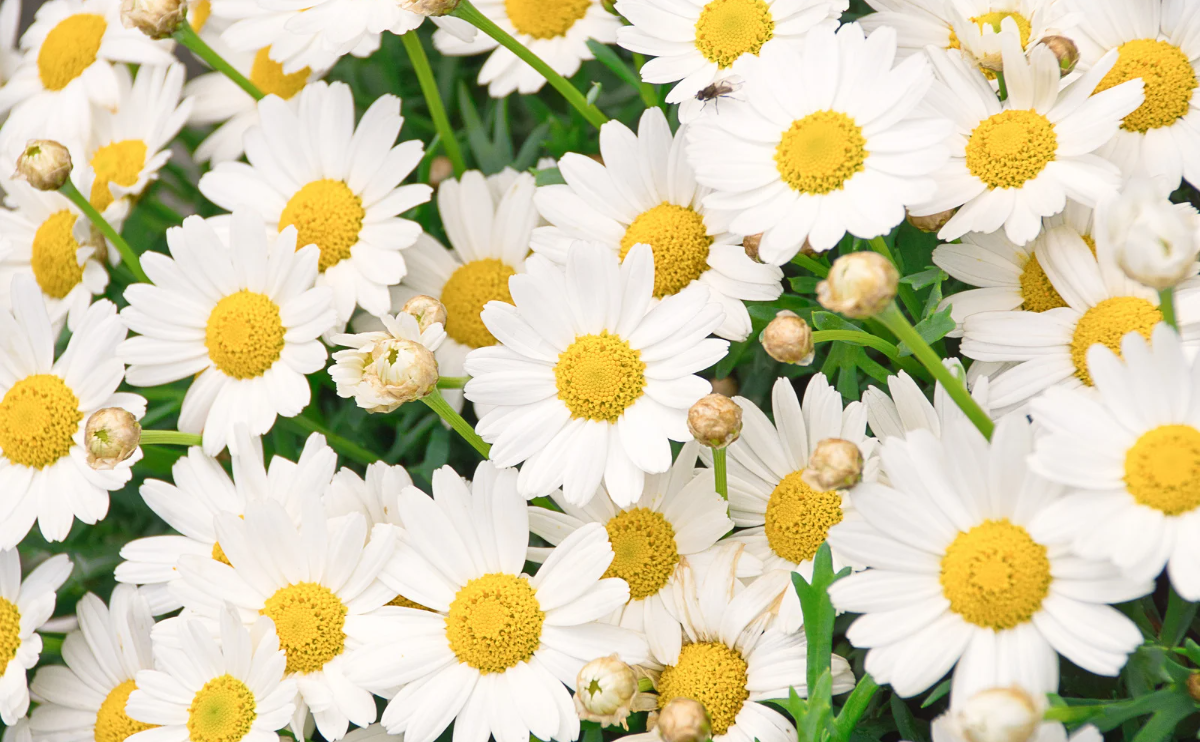Chamomile is a unique European herb that forms a pretty flower with benefits. Chamomile is used for herbal remedies, beverages, and skin care products. There are two types of common chamomile: German and Roman. Both types boast fragrant, daisy-like flowers with white petals surrounding a yellow center.
The two types of chamomile grow quickly (reaching full bloom within about 10 weeks) and are best planted in the spring via seed. Roman chamomile is often used as a ground cover or creeping plant to soften the edges of a stone wall or walkway, while its German counterpart is more commonly used for making tea.

| Common Name | Chamomile, Barnyard daisy |
| Botanical Names | Matricaria recutita, Chamaemelum nobile |
| Family | Asteraceae |
| Plant Type | Annual, perennial |
| Mature Size | 8–24 in. tall, 8–12 in. wide |
| Sun Exposure | Full |
| Soil Type | Well-drained |
| Soil pH | Neutral |
| Bloom Time | Summer |
| Flower Color | White |
| Hardiness Zones | 2-9 (USDA) |
| Native Area | Europe |

When to Plant?
This will be determined by your planting zone. There is a final frost date for each area. As a result, you can plan your gardening activities around this date. Check our Frost Dates Across North America: First & Last Frost Dates Chart. However, the date will not be the same for every plant.
How to Plant
Chamomile may be grown from seed sown early indoors and transplanted outside after frost, or planted as a potted plant.
Sowing Seed Indoors:
Sow chamomile seeds indoors 6-8 weeks before outdoor planting date in spring using a seed starting kit.
As soon as the seedlings emerge, provide plenty of light on a sunny windowsill, or grow seedlings 3-4 inches beneath fluorescent plant lights turned on 16 hours per day, off for 8 hours at night. Raise the lights as the plants grow taller.

Incandescent bulbs will not work for this process because they will get too hot. Most plants require a dark period to grow, do not leave lights on for 24 hours.
Seedlings do not need much fertilizer, feed when they are 3-4 weeks old using a starter solution (half strength of a complete indoor houseplant food) according to manufacturer’s directions.
Sow seeds ¼ inch deep in seed starting formula Keep the soil moist at 70 degrees F
Seedlings will emerge in 14-21 days
If you are growing in small cells, you may need to transplant the seedlings to 3 or 4-inch pots when seedlings have at least 2 pairs of true leaves before transplanting to the garden, so they have enough room to develop strong roots
Before planting in the garden, seedling plants need to be “hardened off”. Accustom young plants to outdoor conditions by moving them to a sheltered place outside for a week. Be sure to protect them from wind and hot sun at first. If frost threatens at night, cover or brings containers indoors, then take them out again in the morning. This hardening off process toughens the plant’s cell structure and reduces transplant shock and scalding.
How to Cultivate
Keep weeds under control during the growing season. Weeds compete with plants for water, space, and nutrients, so control them by either cultivating often or using mulch to prevent their seeds from germinating.
Mulches also help retain soil moisture and maintain even soil temperatures. For herbs, an organic mulch of aged bark or shredded leaves lends a natural look to the bed and will improve the soil as it breaks down in time. Always keep mulches off a plant’s stems to prevent possible rot.
Keep plants well-watered during the growing season, especially during dry spells. Plants need about 1 inch of rain per week during the growing season. Use a rain gauge to check to see if you need to add water. It’s best to water with a drip or trickle system that delivers water at low pressure at the soil level. If you water with overhead sprinklers, water early in the day so the foliage has time to dry off before evening, to minimize disease problems. Keep the soil moist but not saturated. German chamomile tends to reseed readily if the flowers are allowed to remain on the plant. Roman chamomile will form a ground cover.
How to Harvest
How to Harvest Chamomile Picking chamomile is an easy, relaxing enterprise. Gently pinch the stem of the plant just below the flower head. Then place your forefinger and middle finger under the head of the flower, between the flower head and the other pinched fingers, and pop the flower head off.
Remove all the flower heads that are in full bloom and leave behind any that are just budding. Lay the flowers out in a single layer on paper towels or cheesecloth and allow them to dry for 1-2 weeks in a dark, warm, dry area. You can also dry them in the dehydrator at the lowest possible setting. When the flowers are dry and cool, store them in a sealed glass jar for up to 6 months. They can still be used after 6 months, but the flavor is less intense.
Hydroponics
Germination: Start by sprinkling chamomile seeds on top of a moist growing medium, such as rockwool or peat moss. Keep the growing medium moist and in a warm, dark area. After a few days, the seeds should start to sprout. Once they have sprouted, you can transfer them to your hydroponic setup.
pH Range: The pH range for growing chamomile hydroponically should be between 6.0 and 7.0. It’s important to monitor the pH level regularly using a pH meter and adjust it if necessary.
EC: The electrical conductivity (EC) level for growing chamomile hydroponically should be between 1.0 and 1.5 mS/cm. This measures the level of nutrients in the water, so it’s important to monitor it regularly using an EC meter.
PPM: The parts per million (PPM) level for growing chamomile hydroponically should be between 500 and 1000 ppm. This also measures the level of nutrients in the water, so it’s important to monitor it regularly using a PPM meter.
Humidity: The humidity level for growing chamomile hydroponically should be around 50-70%. You can measure the humidity level using a hygrometer and adjust it as necessary by increasing or decreasing the amount of airflow in your grow room.
Light Hours: Chamomile requires at least 12-14 hours of light per day. You can use LED grow lights or natural sunlight to provide the required amount of light.
Temperature Air: The temperature in the grow room should be around 70-75°F during the day and 60-65°F at night. It’s important to keep the temperature consistent to avoid stress on the plants.
Temperature Water: The temperature of the water should be between 65-75°F. You can use a water heater or chiller to maintain the correct temperature.
In summary, growing chamomile hydroponically involves germinating the seeds, monitoring the pH, EC, and PPM levels of the water, controlling the humidity, providing adequate light, and maintaining consistent air and water temperatures. With proper care and attention, you can grow healthy and fragrant chamomile using hydroponics.



